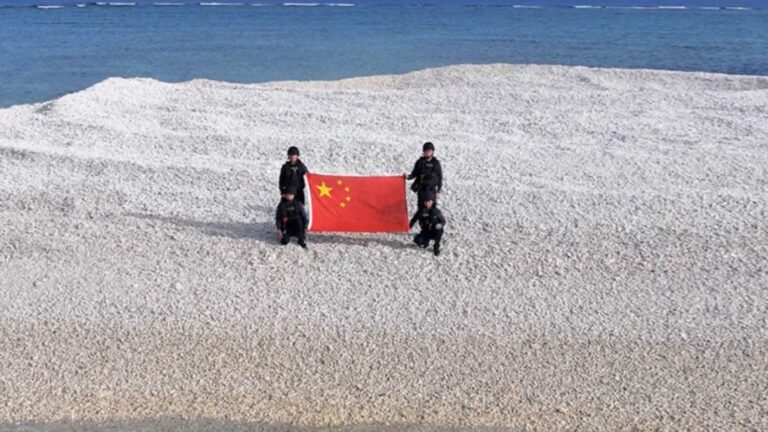Global Strategic and Defence News (GSDN) started its foray on November 11, 2022 as a forum to provide accurate analysis on geopolitical and defence issues that concern the world at large
In The Name Of Love Or Loopholes? Trojan Wives, Stateless Children, And The Silent Infiltration India Refuses To Confront
The April 22 terror attack in Pahalgam didn’t just pierce the illusion of peace in Kashmir, it ripped open a festering wound India has long ignored. As 26 innocent lives were lost, the real question that emerged wasn’t just about who fired the shots but who we’ve let in, unchecked, over the years.
In the name of rehabilitation and reconciliation, India opened its doors in 2010 to former militants returning from Pakistan and Pakistan-occupied Kashmir (PoK) – a policy that was questionable then and disastrous now. What followed was a silent infiltration: nearly 400 women from across the border arrived with these men, some via Nepal, bypassing official immigration routes, documentation, and scrutiny.
Fast forward to 2024 and they are still here. Unvetted. Unverified. Unacknowledged – at least on paper. They have no citizenship, no passports, and no legal status. Yet, they live openly in India, raise families, protest on the streets, and now plead not to be deported.
But can a sovereign country afford this moral confusion in a territory as volatile as Kashmir?

Here are the hard hitting facts –
These women – foreign nationals, mostly from a hostile neighbour – have given birth to over 3,000 children on Indian soil. Children who exist in a legal vacuum, neither recognized nor regulated, yet undeniably part of the population. With each passing year, that number grows. Each new birth is not just a demographic statistic, it’s a potential future flashpoint.
—What kind of nation allows a population of undocumented foreign-origin individuals to grow unchecked in a region known for its historical volatility?
—What happens if conflict reignites?
—What happens if even a fraction of this population is radicalized or manipulated?
It’s not just bad governance. It’s national self-sabotage.
Some of these women now say, “We are already Indian, because we came from PoK.” A convenient claim, but with no legal documentation or verification, how is India even allowing them in?
One woman says she fears deportation because her home, husband, and children are in Kashmir. Another cries for citizenship. And while their emotional appeals tug at the heartstrings, India must remember: this is not about emotion. This is about national security, sovereignty, and strategic clarity.
You cannot enter a country illegally, raise children outside the system, claim rights without proving loyalty, and then expect seamless assimilation – especially in a state like Jammu & Kashmir, where every demographic shift has consequences.
And here’s the most uncomfortable question of all:
If war were to break out tomorrow, who will these families support?
Their husbands may have chosen to lay down arms, but the wives are foreign citizens – raised, educated, and possibly influenced in regions that often spew anti-India sentiment. To presume ideological neutrality is dangerously naïve.
We are not talking about a few couples here. We’re talking about hundreds of families who entered India through the backdoor and are now raising a generation with murky allegiances, no citizenship, and access to one of the most sensitive parts of the subcontinent.

This isn’t prejudice. It’s pattern recognition.
This isn’t xenophobia. It’s geopolitical realism.
Yet India dithers. The Centre is now “collecting data.” A decade and a half later. After multiple red flags. After intelligence warnings. After a brutal terror strike. Is this a response or damage control?
The truth is, the 2010 “return and rehabilitation” policy was launched without foresight or firm guidelines. It allowed former militants and their foreign spouses to slip in through Nepal and melt into Kashmir’s towns and cities. There was no consistent tracking, no biometric recording, no regular verification. Just blind faith in the hope that peace would follow.
But peace isn’t built on wishful thinking. It’s built on secure borders, clear laws, and non-negotiable rules for entry.
And today, we are reaping the consequences.
The children of these unions are now teenagers, many stateless and disillusioned, some possibly resentful of a country that doesn’t recognize them but continues to shelter them. That’s a ticking time bomb. Not every child will turn rogue, but what if just one does?
India must now make hard decisions. Not tomorrow. Today.
Regularize and scrutinize every single undocumented family, either through a clear legal path or through deportation based on security assessments.
Freeze the expansion of such demographic footprints in Kashmir.
End the loophole of backdoor entries through Nepal once and for all.
And most importantly, stop blurring the line between humanitarianism and strategic weakness.
Because here’s the bitter truth –
In matters of national security, indecision is betrayal.
And in Kashmir, every blind spot becomes a battlefield.
US Navy’s Jet Lost! America’s $60 Million Slip In The Red Sea. How America’s Risky War In Red Sea Is Fueling Yemen’s Fault Lines
In a development illustrating the mounting risks faced by US forces in the Red Sea, a US Navy F/A-18 Super Hornet fighter jet was lost overboard from the USS Harry S. Truman while being towed aboard the carrier, the Navy confirmed on Monday.
According to US officials, preliminary assessments indicate that a hard evasive maneuver by the Truman, necessitated by incoming Houthi fire, contributed to the mishap. Yemen’s Iran-backed Houthi rebels claimed responsibility for a drone and missile attack on the carrier, which remains deployed in the Red Sea as part of Washington’s broader military operations aimed at countering Houthi threats to maritime security.
Nimitz-class carriers like the Harry S. Truman, though immense in size at nearly 1,100 feet and displacing close to 100,000 tons, are capable of impressive agility, driven by twin nuclear reactors and capable of speeds exceeding 30 knots. While specific details of the ship’s maneuver remain classified, available imagery and historical data confirm that these warships can sustain dramatic heeling during high-speed turns.
All personnel aboard the Truman have been accounted for, with only one sailor reported to have suffered minor injuries.
“The F/A-18E was under tow in the hangar bay when tow operations lost control of the aircraft, resulting in the aircraft and the tow tractor falling overboard,” the Navy’s statement said.
An official later confirmed that the $60 million fighter jet has sunk. An investigation into the incident is underway. Despite the loss, the Navy emphasized that the Truman Carrier Strike Group and its embarked air wing “remain fully mission capable.”
This is not the first time the Truman has found itself in Houthi crosshairs. In February, the carrier collided with a merchant vessel near Egypt – thankfully without casualties. In December, another F/A-18 from the Truman was mistakenly engaged and downed by the guided-missile cruiser USS Gettysburg during heightened alert operations in the Red Sea, though both pilots survived.

The latest incident takes place against the backdrop of an increasingly volatile maritime theater. US naval vessels operating in the Red Sea have repeatedly faced Houthi missile and drone attacks, prompting close-quarter defense measures such as the activation of Phalanx CIWS systems to intercept projectiles at dangerously short ranges.
The Houthi escalation follows intensified US military engagement in the region after the group’s sustained attacks on commercial shipping, acts they claim are in solidarity with Palestinians amid the ongoing Israeli military campaign in Gaza.
In March 2025, the United States escalated its response with a series of precision air and naval strikes against key Houthi military infrastructure across western Yemen. These operations, spanning March 15–19, were designed to neutralize Houthi air defenses, missile platforms, and radar networks that posed imminent threats to regional maritime traffic.
However, these strikes have also inflamed broader geopolitical tensions. The Houthis, resilient after years of asymmetric warfare, swiftly retaliated with fresh missile and drone barrages targeting US naval assets, signaling their intent to prolong the confrontation.
In statements following the US strikes, Houthi leadership vowed to continue operations “in support of the Palestinian people” and warned that American “aggression” would only “intensify the scale of targeting and confrontation.”
On Monday, Houthi officials alleged that a US airstrike had struck a detention facility housing African migrants, resulting in heavy casualties, an allegation the Pentagon has not yet addressed.
As Washington pledges to maintain military pressure until Red Sea shipping lanes are secured, critical questions arise – Can the United States achieve its strategic objectives without being drawn into a deeper quagmire? Or does this campaign risk becoming another protracted entanglement in a region historically resistant to external military solutions?
The coming weeks are likely to test not just American military capabilities, but also its broader strategic patience and geopolitical calculus in a region where adversaries are increasingly emboldened.

The Cost Of Military Attacks
The recent U.S. military strikes against Yemen’s Houthi rebels may unintentionally reinforce the group’s domestic legitimacy by validating its long-standing narrative of resistance to foreign aggression. Historically adept at framing themselves as defenders of Yemeni sovereignty against external powers, the Houthis are likely to leverage these operations to galvanize internal support and further entrench their control.
In the wake of the strikes, mass mobilizations in Yemeni cities illustrates a surge in anti-American sentiment, with tens of thousands rallying in defiance of what they perceive as unjustified foreign aggression. These public demonstrations not only reflect widespread popular resentment but also suggest that U.S. intervention may serve to unify disparate Yemeni constituencies under the Houthi banner. In doing so, external pressure inadvertently aids in the consolidation of Houthi political authority.
Such dynamics are also indicative of a broader strategic paradox: military campaigns designed to degrade militant capabilities can, under certain conditions, bolster insurgent legitimacy by inflaming nationalist sentiment and deepening the perceived moral divide between occupiers and the occupied.
Israel-Iran Axis
President Donald Trump’s authorization of sustained operations against the Iran-aligned Houthis signals a broader strategic objective – namely, deterring Tehran’s proxy architecture across the region. By striking Houthi positions, Washington is sending an unambiguous warning to Iran: support for militant proxies will carry consequences that may escalate beyond indirect confrontation.
This calibrated use of force comes amid mounting regional tension between Israel and Iran, with Yemen increasingly viewed as a theater in the broader geopolitical contest between these two regional rivals. Trump’s rhetoric, equating Houthi actions with direct Iranian aggression, places the current military engagement in Yemen within the larger framework of U.S. containment strategy aimed at Tehran’s regional ambitions.
The military dimension of this confrontation adds complexity to an already volatile landscape, where asymmetric actors operate across blurred lines of state and non-state warfare. By targeting the Houthis, the U.S. is not merely seeking to secure maritime lanes – it is staking a position in the wider strategic chessboard of Middle Eastern power politics.

Unintended Consequences
While aimed at ensuring the security of global maritime trade and deterring proxy aggression, the U.S. military campaign in Yemen risks triggering a cascade of unintended consequences with far-reaching regional implications.
Civilian casualties resulting from U.S. strikes – reportedly exceeding 50 deaths, including non-combatants – have inflamed public opinion across the Middle East. These losses risk undermining Washington’s moral standing, fostering resentment that militant groups can exploit to justify further attacks. Far from diminishing Houthi capabilities, the strikes may embolden the group, as evidenced by its public vow to continue targeting Israeli-linked vessels and its disregard for Tehran’s calls for de-escalation.
The broader danger lies in regional spillover. Given the Houthis’ strategic ties to Iran, U.S. operations in Yemen are likely to be interpreted in Tehran as escalatory, thereby increasing the risk of retaliatory actions across other flashpoints, including the Strait of Hormuz, Iraq, and Syria. U.S. allies such as Saudi Arabia and Gulf states may find themselves further exposed to retaliatory strikes, dragging the region into a wider confrontation.
Ultimately, while the intent of these operations is to protect critical shipping corridors, their execution in a highly fragmented and ideologically charged environment risks compounding regional instability. A sustainable approach requires more than tactical strikes, it demands a strategic framework that mitigates the geopolitical fallout and prioritizes long-term stability over short-term military gains.
Flag Wars In The South China Sea: China And Philippines Stake Competing Claims On Disputed Sandbars
China and the Philippines have each raised their national flags on tiny sandbars in the South China Sea, staking competing sovereignty claims in waters that have become a potential flashpoint for global conflict.
The rival flag-raising occurred on Sandy Cay, a cluster of three uninhabited sandbars near a Philippine military outpost in the disputed Spratly Islands.
The release of these images comes as US and Philippine forces conduct their largest-ever joint military drills in nearby waters – just weeks after US Defense Secretary Pete Hegseth pledged to strengthen the US-Philippines military alliance to counter China’s regional aggression during his first Asia trip.
Parts of the South China Sea, vital to global trade, are claimed by multiple nations. However, China asserts near-total control, defying an international court ruling. Over the past two decades, China has built military installations on reefs and atolls far from its coastline.
The public relations battle over Sandy Cay risks intensifying tensions between the Philippines and China and presents a key test for US policymakers, especially with Trump administration officials stressing the need to counter China’s growing influence in the Indo-Pacific.
Competing Claims
The latest dispute surfaced when China’s state-controlled media claimed that its Coast Guard had asserted maritime control over Tiexian Reef (Sandy Cay) in mid-April. Photos aired by Chinese state broadcaster CCTV showed Chinese officers on the sandbar, raising a flag as part of a demonstration of sovereignty.
CCTV reported that China’s Coast Guard officers had “patrolled” the reef and collected evidence of alleged illegal activities by the Philippine side, also cleaning up debris.
In response, the Philippines quickly organized a publicity effort, sending naval and coast guard teams to various sandbars, including Pag-asa Cay (Sandy Cay), where they observed the presence of Chinese vessels.
A photo posted by a Philippines Coast Guard spokesperson showed officers raising the Philippine flag on the sandbar. Philippine officials claimed that China had falsely reported its control over the area, releasing photos and videos to debunk the disinformation.
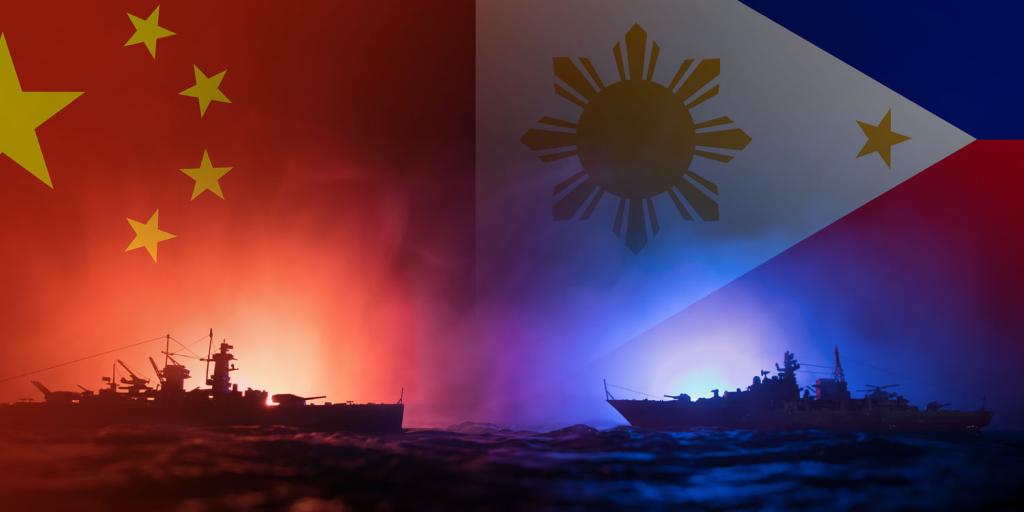
Military Alliances and Escalating Tensions
Sandy Cay lies near Thitu Island, also known as Pag-asa Island, which houses a Philippine military facility. In 2023, Manila opened a coast guard base there in response to Chinese aggression. Under the Biden administration, US officials have assured the Philippines of defense support in case of an attack in the South China Sea.
As the US and Philippine military drills kicked off in April, the US deployed an anti-ship missile launcher for the first time in northern Philippines, near Taiwan, further straining relations with Beijing. This year’s Balikatan exercises, also featuring Japan’s participation, are a sign of expanding security cooperation in the region.
Denying Chinese Claims
The Philippines has rejected China’s assertion that it had “dealt with” a mission involving Filipino personnel who allegedly landed on the disputed reef. Chinese authorities claimed that they had “investigated” the situation and urged the Philippines to stop its alleged infringement.
Manila officials denied that China had seized Sandy Cay or interfered with the Philippine mission, labeling China’s statements as part of disinformation tactics. They pointed to photos showing the Philippine flag raised on the sandbars, disputing China’s claims of territorial sovereignty.
In response to the military exercises and escalating tensions, Chinese media noted that Beijing’s flag-raising on Sandy Cay was a significant move to assert its claim, especially ahead of US-Philippine military drills, sending a message to both Manila and Washington.
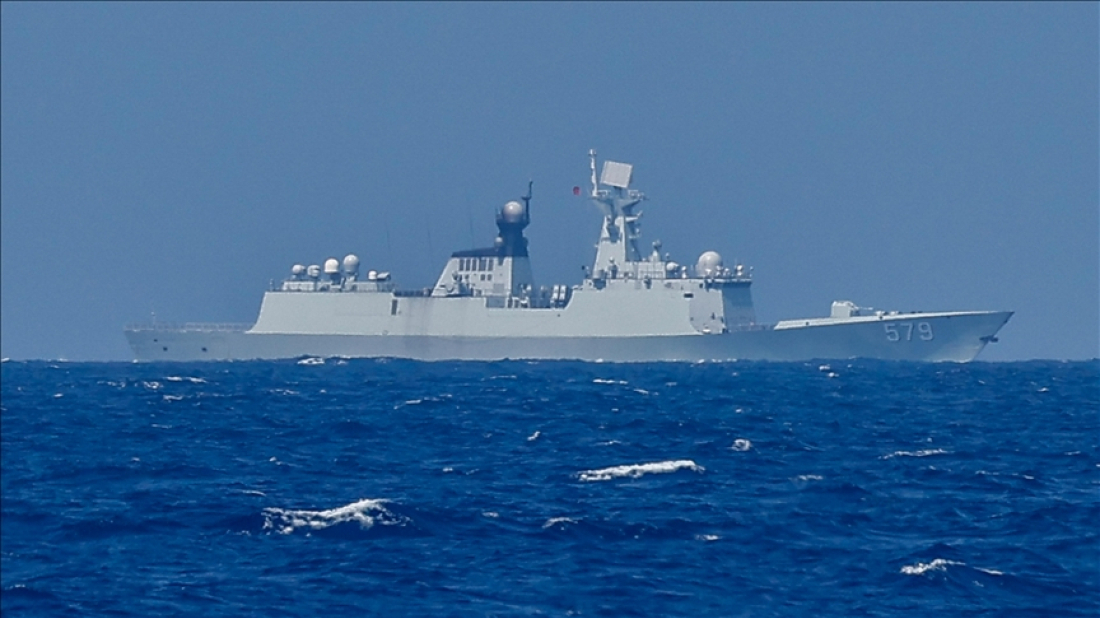
What’s Behind Escalating China-Philippines Tensions in the South China Sea?
The territorial dispute between China and the Philippines in the South China Sea has intensified, with violent confrontations becoming increasingly frequent. Allegations of intentional boat rammings, the use of water cannons, and physical altercations involving spears and knives between the two nations’ forces have escalated tensions. In August 2024 alone, the two countries reported six confrontations, five of which occurred near Scarborough Shoal and the Sabina Shoal, located within the Philippines’ 200-nautical-mile Exclusive Economic Zone (EEZ) but claimed by China.
Despite efforts from both sides to manage their maritime dispute, the situation remains volatile. The confrontations follow a violent clash in June, where a Filipino sailor lost a finger. China has accused the Philippines of intruding into its territory, while Manila insists that Beijing’s actions are unlawful. In September, Beijing warned that its relationship with the Philippines stood at a “crossroads,” urging Manila to reconsider its stance.
The growing tensions have prompted concerns from the United States, a long-time ally of the Philippines. Under their mutual defense treaty, the U.S. has pledged to defend Philippine troops from any armed attacks, including those targeting coastguard personnel, aircraft, or vessels in the South China Sea.
Who Claims What?
The South China Sea is a vital and contested waterway, with China claiming nearly all of it via a vague, U-shaped “nine-dash-line” that overlaps with the EEZs of several nations, including the Philippines. This massive claim extends over important areas such as the Paracel and Spratly Islands. The Philippines, along with Brunei, Malaysia, and Vietnam, also claims parts of the Spratlys, while China maintains dominance over many of these islands, particularly since 1974.
In 2016, a United Nations tribunal ruled that China’s claims based on the nine-dash-line lacked legal grounding, but Beijing has ignored the verdict, continuing to militarize reefs and submerged shoals in the region.
China’s Military Build-up in the South China Sea
Since 2013, China has undertaken extensive land reclamation efforts in the Spratlys, adding 3,200 acres of new land. These artificial islands now feature military outposts, including large runways and ports capable of hosting military aircraft and assets. China’s military presence includes anti-ship and anti-aircraft missiles, strengthening its strategic foothold in the region.
The Philippines and Vietnam have also established their own outposts in the South China Sea, but none match China’s scale or military infrastructure.
Why is the South China Sea So Important?
The South China Sea is a critical trade route, with cargo worth $3.4 trillion passing through it annually. It also harbors rich fishing grounds, essential for the livelihoods of millions of people. The waters are believed to contain significant oil and gas reserves, with potential reserves worth over $2.5 trillion. Control of these resources is key to energy security for the region’s nations.
China’s military presence serves not only to exert control over vital resources but also to deny foreign military access, particularly from the United States. This has led to direct confrontations with vessels from other claimant nations such as Vietnam, Malaysia, and the Philippines, which have sought to explore and exploit these resources.
Increasing Clashes
The dispute is not new. Over the decades, China has clashed with both Vietnam and the Philippines over sovereignty claims. In 1974, China seized the Paracels from Vietnam, resulting in the deaths of more than 70 Vietnamese troops. The Philippines has faced its most significant challenges over Scarborough Shoal and Second Thomas Shoal. In 2012, China seized Scarborough Shoal after a tense standoff, and more recently, Chinese forces have attempted to block Filipino ships delivering supplies to troops stationed on Second Thomas Shoal.
The use of military-grade lasers, boat rammings, and water cannons has become a tactic of choice for China in asserting its dominance. These confrontations highlight the ongoing volatility in one of the world’s most strategically important maritime regions.
Indian Navy Launches Missile Tests As Tensions Escalate With Pakistan Following Deadly Kashmir Attack
The Indian Navy test-fired missiles on Sunday, signaling its formidable ability to execute “long-range, precision offensive” strikes, as military tensions between India and Pakistan reached new heights in the aftermath of last week’s terrorist attack in Indian-administered Kashmir. The attack, which resulted in the deaths of 26 civilians, targeted a popular tourist site and marked the deadliest assault on civilians in the region in over 25 years.
The Indian Navy’s missile test served as a message, confirming its readiness to respond with precision and power.
“Indian Navy ships undertook successful multiple anti-ship firings to re-validate and demonstrate readiness of platforms, systems, and crew for long-range precision offensive strike,” the Navy stated on X.
The message, carefully timed, resonated against the backdrop of Prime Minister Narendra Modi’s promise of a “harsh response” to the attack. The statement was not an empty threat; it was part of Modi’s broader strategy of rallying global support and building domestic consensus for a more aggressive stance.
In his monthly radio address, Modi remarked that the attack had left every Indian’s blood “on the boil,” an expression of national outrage and a clear indication that the government was not going to let the killings go unpunished. His words echoed past promises of retribution, he had previously vowed to hunt down the perpetrators “to the ends of the Earth” and to reduce terrorist hideouts to “dust.”
These declarations were a strategic attempt to not only justify retaliation but to also bolster national sentiment during a time of heightened emotions. While Modi was quick to express his anger, he was also aware that such rhetoric would carry significant weight on the international stage, influencing foreign leaders’ positions on the issue.
The missiles launched were a direct demonstration of India’s military capabilities. These weapons, designed for long-range precision strikes, serve as a warning shot to Pakistan. The Navy emphasized that the exercises were essential for maintaining “operational readiness,” particularly in an environment where military tensions are rapidly escalating. As India flexed its military muscles, Pakistan, already on edge, responded with equally intense rhetoric, indicating its own nuclear prowess.
On the weekend, Pakistan’s railway minister, Hanif Abbasi, issued a chilling statement about the country’s nuclear arsenal. “It is not kept as models,” Abbasi said. “These ballistic missiles, all of them are targeted at you.”
The comment underscored the ever-present threat of nuclear conflict between the two countries, who have fought three wars, two of them over the contested Kashmir region. Both nations possess nuclear weapons, and the reality of that fact weighs heavily on the region’s geopolitical arena.
Abbasi’s remarks stoked fears that the nuclear-armed neighbors were once again edging closer to a larger confrontation, a sentiment shared by many analysts around the world.

The Kashmir Issue
The long-standing conflict over Kashmir has seen both sides on the brink of war multiple times. The region, which both India and Pakistan claim in full, has served as the flashpoint for decades of military confrontations. The former U.S. president Bill Clinton once called Kashmir the world’s “most dangerous place,” given the nuclear capabilities of both nations and their seemingly unending rivalry.
The contrasting military doctrines of the two nations add a layer of volatility to the already fragile peace. Pakistan’s military strategy, known as Full Spectrum Deterrence, emphasizes the use of tactical nuclear weapons to deter conventional threats, while India’s Cold Start doctrine seeks to launch swift conventional strikes before tensions can escalate to nuclear warfare. This sharp divergence in strategies has led to concerns that any military engagement could quickly spiral out of control.
Michael Kugelman, a prominent foreign policy author and analyst, commented on the likelihood of military escalation. “From Delhi’s perspective, given public pressure, the egregiousness of last week’s attack, and a desire to restore deterrence, some type of military response is quite likely,” Kugelman said.
He also warned that Pakistan, feeling the need to maintain its credibility in the region, would almost certainly retaliate. “And given that these are nuclear-armed rivals, the stakes are quite high,” he added. While Kugelman suggested that an all-out war was unlikely, he also acknowledged that the risk of miscalculation or unintended escalation could never be completely ruled out, particularly if military actions on either side are not carefully calibrated.
Riding On The Back Of Terrorism
India has accused Pakistan of being complicit in the attack, citing the historical links between Islamabad and militant groups that have targeted India in the past. The government has pointed to the country’s long-standing support for anti-Indian terrorist organizations. The attack’s brutality, targeting Hindu men in particular, has further fueled accusations of Pakistan’s role in fomenting such violence.
In response, India has undertaken a series of punitive actions: suspending the Indus Waters Treaty, expelling Pakistani diplomats, and canceling visas. These measures have escalated the tensions, with Pakistan retaliating by expelling Indian diplomats, closing its airspace, and suspending the 1972 Shimla Agreement.
While Modi’s government remains steadfast in its commitment to retaliation, Pakistan’s Prime Minister Shehbaz Sharif has taken a more measured approach. In a speech, Sharif expressed Pakistan’s “strong desire for peace” and offered to cooperate with neutral investigators to probe the attack. However, he reiterated that Kashmir remains Pakistan’s “jugular vein,” a sentiment famously articulated by the country’s founder, Muhammad Ali Jinnah.
Sharif’s diplomatic overtures, while conciliatory, are likely a response to mounting pressure from both domestic and international sources to de-escalate the situation. At the same time, his remarks suggest that Pakistan will not back down on the Kashmir issue, which remains a core element of the nation’s identity and foreign policy.
As the situation deteriorates, both Indian and Pakistani troops have exchanged fire along the Line of Control (LoC) in Kashmir for three consecutive days, further complicating efforts to reach a peaceful resolution.
The LoC, a heavily militarized border that divides Kashmir between the two countries, has long been a flashpoint for skirmishes and clashes. The exchange of fire comes as speculation mounts about the possibility of a larger military response from India. In anticipation of such action, India’s Information Ministry issued a media advisory, warning against live broadcasts of military operations. The move reflects concerns over the risks posed by real-time coverage, which could compromise military strategies and escalate tensions, as seen in previous crises like the 1999 Kargil War and the 2008 Mumbai attacks.
On the ground, India has launched a broad crackdown in Kashmir, targeting suspected militants and dismantling what it refers to as the “terrorism ecosystem.” The operation has resulted in the demolition of at least 10 homes linked to militants and the detention or questioning of approximately 1,500 young men.

Rights groups have raised alarm over the widespread detentions, accusing Indian forces of using heavy-handed tactics that could exacerbate the already volatile situation. The crackdown also reflects India’s determination to disrupt the networks that feed anti-Indian sentiment in the region.
Tensions have also spilled over into the water dispute between the two nations. India’s decision to release water from the Uri Dam, which caused the Jhelum River to surge and flood parts of Pakistan-administered Kashmir, has sparked further anger in Islamabad. The release of water was seen as a direct violation of the Indus Waters Treaty, which governs the distribution of water resources between India and Pakistan. Pakistan has warned that any further interference with water would be considered an “act of war,” adding another layer of complexity to an already volatile situation.
Behind Closed Doors. Documents Reveal Deep Divisions In Ukraine Peace Talks. What’s The Drama This Time?
Ukrainian and European officials aren’t exactly on board with some of the latest U.S. ideas on how to end the war in Ukraine, and they have made their own counterproposals, touching on everything from territorial control to sanctions.
Full versions of the proposals offer a rare glimpse into the ongoing back-and-forth diplomacy behind closed doors. The documents come from two key rounds of talks, one in Paris on April 17 and another in London on April 23 , and they reveal just how complex and divided the negotiations have become as President Donald Trump pushes hard for a quick peace deal.
The main sticking points, as per documents – how and when to settle territorial issues, whether sanctions on Russia should be lifted, what kind of security guarantees Ukraine should get, and how big its military should be. Some of these disagreements had been hinted at before, but the documents spell them out in black and white.
According to sources, the first proposal, labeled as the “final offer” from the U.S., was put together by Trump’s envoy, Steve Witkoff, and first shared with European officials in Paris before being passed along to Ukraine.
U.S. Secretary of State Marco Rubio called the proposal a “broad framework” to get all sides aligned. But Vice President JD Vance took a firmer line, saying the U.S. had laid out a very clear deal and it was time for everyone to either get on board or risk the U.S. walking away from its peace efforts.
Meanwhile, the counterproposal, drawn up by Ukrainian and European officials in London, was sent over to the American side this week. President Zelenskiy confirmed on Thursday that the document from the London talks was now in front of Trump.
And as of Friday, Witkoff was in Moscow, meeting with President Vladimir Putin, another sign of just how serious and fast-moving this peace push has become. It’s the most intense diplomatic effort to stop the war since the early days of Russia’s full-scale invasion in 2022. As things stand, Moscow controls about 20% of Ukrainian territory.

Where the Major Differences Lie
When it comes to territory, the proposals from Trump’s envoy Steve Witkoff suggest that the U.S. would legally recognize Russia’s control over Crimea, the peninsula Moscow grabbed back in 2014 and de facto recognize Russian control over parts of southern and eastern Ukraine currently occupied by its forces.
On the other hand, the European and Ukrainian counterproposals take a very different approach: they suggest putting off any serious discussion about territorial issues until after a ceasefire is in place. And importantly, there’s no mention whatsoever of recognizing Russian control over any Ukrainian land.
The Crimea issue, not surprisingly, has turned into a major flashpoint. This week, Trump criticized President Zelenskiy after the Ukrainian leader doubled down on Kyiv’s stance that it would never recognize Crimea as Russian territory. Trump, in an interview with Time magazine, was blunt: “Crimea will stay with Russia,” he said, adding that he didn’t think Ukraine would ever be allowed into NATO.
Security Guarantees, Worlds Apart
The Witkoff proposal says Ukraine would get a “robust security guarantee,” backed by Europe and other friendly countries, but it’s pretty vague on the details. One thing it does say clearly – Ukraine would not join NATO.
Meanwhile, the European and Ukrainian side lays out much stronger terms. Their proposal allows Ukraine to have an unrestricted military, invites allied forces to set up shop on Ukrainian soil, and calls for serious security promises, something similar to NATO’s Article 5 mutual defense pact. Unsurprisingly, these ideas are likely to ruffle a few feathers in Moscow.
Economic Measures, Not Much Alignment Here Either
On sanctions, the U.S. proposal suggests lifting the measures placed on Russia since its 2014 Crimea annexation as part of the peace deal.
The counterproposal is a lot tougher. It says U.S. sanctions could only gradually be lifted after a stable peace is achieved and if Russia breaks the deal, the sanctions could snap right back. Plus, Ukraine would get financial compensation for war damages from Russia’s frozen overseas assets, while the U.S. proposal just vaguely mentions compensation without explaining where the money would come from.
The Pressure Cooker
Both Kyiv and Moscow are racing to show Trump that they’re making progress toward his goal of a quick peace deal, especially after the U.S. hinted it might walk away from the process if things drag on.
Zelenskiy admitted the talks in London were tough but called them “constructive.”
However, not everyone’s feeling optimistic. Three European diplomats stated that they initially thought the Paris talks were promising, a good first step toward hammering out differences ahead of the London round. But soon after, they sensed that U.S. negotiators were under heavy pressure to get a deal moving quickly. That raised alarm bells that Ukraine and Europe might end up backed into a corner, forced to accept terms they aren’t happy with.
In London, the main aim was to pull together the joint European and Ukrainian counterproposal for U.S. envoy Keith Kellogg to carry back to Washington, setting the stage for the next round of this diplomatic chess match.
Pahalgam Massacre, A Message Written In Blood. But Who Was It Really For And By Whom?
On April 22, 2025, the calm of Pahalgam in Jammu & Kashmir was torn apart by a brutal terror strike. 27–28 civilians were slaughtered. Not killed – slaughtered. Another 15–20 left clinging to life. But this wasn’t just another act of senseless violence. No. This was a blood-soaked communiqué – carefully timed, surgically executed, and chilling in its clarity.
Let’s Not Sugarcoat It- The Targets Were Hindu Civilians
Forget the sanitized headlines talking about “generic terrorism.” This was a targeted communal strike. Hindu civilians were singled out. This wasn’t collateral damage or a random act of terror – it was sectarian cleansing. The attackers, linked to Islamist groups with Pakistani DNA and aided by a local sleeper network, made their message loud and grotesquely clear.
And yet, some continue parroting the tired line – “terror has no religion.” That’s convenient. But in this case, wrong. Deliberate targeting of one community is ideological warfare. Let’s call it what it is.
The Timing Was No Coincidence, Who Landed in India on April 21?
While India bled, guess who was sipping chai with top Indian officials – U.S. Vice President J.D. Vance. He arrived on April 21, and the bullets started flying on April 22. Coincidence, Maybe. Strategic message, Most likely.
His visit, the agenda was razor-sharp – grow Indo-U.S. economic ties and counterbalance an increasingly cornered China. And right when that conversation was heating up, terrorists lit a fire in Kashmir. Ask yourself, who benefits when the India-U.S. partnership is disrupted or distracted?

China’s Meltdown Mode, Tariffs, Tantrums, and Tactical Diversions
Let’s not forget what else was brewing. The U.S. just dropped a nuclear-grade economic bomb on China, a monstrous 245% tariff on Chinese goods.
Now China, the world’s factory, is scrambling. It’s making doe-eyed gestures toward India, pretending to welcome Indian exports. Don’t fall for it. China doesn’t import. It controls.
The fear in Beijing is simple and real – India is becoming the world’s next big supply chain hub. Apple, Google, Amazon, they’re all moving ops to India. If this shift accelerates, China’s global grip unravels.
Pakistan’s Relevance Crisis + China’s Strategic Panic = Pahalgam
Let’s stitch it together, a top U.S. official visits India – skips Pakistan entirely. India is rising in Washington’s Indo-Pacific plans. Pakistan is reduced to a footnote. China is on the backfoot, tariffs cutting deep, exports piling up, domestic consumption stalling.
So what happens? A brutal, high-visibility terror strike during the VP’s visit. Hindu civilians executed. Headlines hijacked. Global attention diverted. And the message very clear – India is not safe, not stable, not ready to lead.
The Indo-Pacific Isn’t Just Strategy Anymore – It’s the New Frontline
From rerouted Chinese goods in Southeast Asia to desperate ASEAN diplomacy, China’s grip is slipping. The Indo-Pacific is no longer Beijing’s backyard, it’s a battleground for influence, trade, and global alignment. Every U.S. handshake with India is a threat. Every missed stop in Islamabad is a snub.
So yes, Pahalgam was a massacre. But more than that, it was a warning shot. Not just for India. But for Washington too. Stay close to India, and this is what you’ll see.
Was this massacre designed to remind the world, and especially Washington, that India still bleeds in Kashmir? If so, the message was received, and written in blood.

Look East – Bangladesh is Quietly Tilting Red
Zoom out. What’s happening in Bangladesh should be ringing sirens in New Delhi. Chinese money is flooding into Dhaka, not just for roads and ports, but for control. Beijing is modernizing Mongla Port, just a stone’s throw from India’s most vulnerable artery, the Siliguri Corridor, aka the Chicken’s Neck.
And India? It’s not blind. The deployment of S-400s and Rafale jets in this region isn’t coincidence. It’s counter-pressure. Because one wrong move near that corridor, and India’s northeast could be cut off like a limb – it’s strategic reality.
China’s Encirclement Game: Death by a Thousand Partnerships
Further west, the dragon cuddles up tighter with Pakistan, planning joint military ops, space programs, and maybe even astronaut selfies. So, let’s connect the dots –
Tensions in Ladakh and Arunachal.
China’s naval chokeholds in the Indian Ocean.
The Bangladesh economic flirtation.
Pakistan’s loyal servitude.
This is what strategic encirclement looks like. China doesn’t need to invade. It just needs to box India in, strangle its supply chains, stretch its military thin, and whisper instability into the ears of global investors.
Beijing’s Panic Playbook — Disrupt, Delay, Divert
Post-COVID, post-tariffs, and post-global-wake-up-call, China is hemorrhaging control. U.S. slapped a 245% tariff wall on Chinese goods, and now its export-led economy is gasping. American giants are jumping ship. India is the next stop.
And that’s exactly what China fears, India as the next factory of the world.
So what’s the strategy?
Keep India distracted. Stir the pot in Kashmir. Spark internal chaos. Reignite old fault lines. Make investors nervous. It’s cheaper than war, and just as effective.
And Then There’s Pakistan – Always Ready with the Matchstick
Let’s not ignore what Pakistan’s Army Chief, General Asim Munir, said on April 7. He didn’t preach unity. He didn’t call for peace. Instead, he told Pakistani citizens to teach their children the “difference between Hindus and Muslims.” He spoke of 1947. Partition. Ideology.
Weeks later, Pahalgam happens and who are the targets? Hindu civilians. Again, not a coincidence. A provocation. Possibly, a state-backed one.

Why Now? The Silence Is Broken – But What Changed Behind the Scenes?
For months, maybe even years, Pakistan kept a calculated hush in Kashmir. No major strikes. No overt provocations. Just the occasional diplomatic jab. So why now? Why Pahalgam, and why this moment?
First instinct says: maybe it’s about disrupting Indian elections. But there are none happening right now. No national polls, no state elections, not even a local bypoll worth the bloodshed.
So, strike that theory off the board. Pressure Cooker in Rawalpindi?
Sure, the Pakistani military is under heat. The post-Imran Khan political chaos has made the generals look less like guardians of the nation and more like bloated landlords with a PR problem. But picking a fight with India, a regional giant with far superior firepower and economic clout, isn’t how you deflect criticism.
Unless, of course, someone else is underwriting the gamble. Someone like, say, Beijing?
And now, we’re getting warmer.
Geopolitical Signaling: The Real Motive?
India’s growing global gravitas is impossible to ignore. With New Delhi tightening its handshake with Washington, cozying up to Tel Aviv, and forging key Gulf alliances, the power equation is shifting, and not in Pakistan or China’s favor.
Why Pahalgam? Because it’s a jewel in India’s tourism crown. It hosts pilgrims, honeymooners, peace-seekers. Attacking here is psychological warfare, meant to destroy a sense of normalcy and safety.
And let’s not ignore the tactical precision. These attackers didn’t shoot in the dark, they knew where to hit, when, and whom. That level of intel doesn’t come from Twitter. It screams insider help.
India Responds With Hydrological Muscle
Instead of waiting for an apology that’ll never come, New Delhi hit Islamabad where it hurts – water. By suspending key Indus Waters Treaty arrangements, India is now flexing real leverage. The move restricts river flows into Pakistan, a country already teetering on economic collapse.
And that? That’s not just retaliation, that’s a signal – “If you light fires, we’ll dry up the rivers.”
Pakistan Knew the Trap Was Set. Now, the Game Is On.
Pakistan had prepared for India’s retaliation well in advance.
The moment India moved to divert Indus waters, Pakistan was ready to scream “act of war.”
Think about the absurdity – you harbor terrorists, send them across borders to kill civilians, and when the victimized country uses legitimate diplomatic tools, you play the victim.
This strategic whining allows Pakistan to keep tensions at a simmer, just below full-blown war, while standing in global forums crying foul. It’s a tired game, but one that still finds a few takers in the international community.
But why hasn’t India struck back militarily yet?
Because unlike Pakistan’s reckless adventurism, India’s decisions are strategic, not emotional.
A direct military strike could spiral into an all-out war. But more crucially, does Pakistan even have the stomach, or the cash, for a war?
Pakistan Is Broke. Period.
Pakistan’s economy today is a house of cards. They can barely pay salaries, fund their imports, or keep the lights on, let alone wage a war against a country like India.
So, why risk it all?
Because someone is underwriting the risk.
Who’s Writing Pakistan’s Blank Check?
Two names emerge, unmistakably –
China: Nervous about India’s growing Indo-Pacific role, desperate to slow its ascent.
The United States: Historically addicted to the “strategic leverage” Pakistan offers near Afghanistan and Iran.
Today, with India emerging as a global manufacturing alternative and America hardening its stance on China, Beijing is jittery.

The Last Word
Indians are done with lip service.
The mood is different now. It demands action – not symbolism, not diplomacy-only posturing.
Pahalgam was not just an attack on tourists. It was an attack on India’s confidence, its soft power, and its dignity.
This is a defining moment. One that will redraw India’s national security doctrine.
One that will warn the world – you fund terror at your peril.
As PM Modi declared: “Those who orchestrate terror will not escape.”
And this time, India’s vengeance will be deliberate, multi-dimensional, and final.
Pentagon Power Couple? Pete Hegseth’s Wife Raises Eyebrows Inside Defense Circles. Why Jennifer Hegseth’s Pentagon Presence Alarms Insiders
Over the weekend, renewed attention turned toward Jennifer Hegseth, wife of U.S. Defense Secretary Pete Hegseth, after revelations that she was included in a second encrypted group chat where the Secretary reportedly shared details about sensitive military operations. The development has reignited scrutiny over her visible, yet unofficial, role within the Pentagon during her husband’s relatively short tenure as the head of the U.S. Department of Defense.
Jennifer Hegseth has been closely involved in her husband’s professional orbit since before his confirmation to the Cabinet post. Her participation in high-level discussions was highlighted anew when it emerged that she was part of a Signal group chat with Secretary Hegseth, his brother Phil, and his lawyer Tim Parlatore, a group in which the Secretary is said to have discussed military actions against the Houthi rebels.
While both Phil Hegseth and Tim Parlatore currently hold official roles within the Defense Department, Jennifer Hegseth does not hold any formal position. According to a source familiar with the matter, she submitted paperwork seeking a security clearance, though it remains unclear whether that clearance was granted. A Pentagon spokesperson declined to comment on the status of any individual’s security clearance, citing standard policy. However, Pentagon press secretary Kingsley Wilson stated that Jennifer Hegseth “has never attended a meeting where sensitive or classified information was discussed.”
Several sources have indicated that Secretary Hegseth, increasingly wary of internal leaks to the media, has chosen to surround himself with a tight-knit group of confidants – a circle that notably includes his wife.

The Signal group chat in question was reportedly created during the confirmation process as a means to coordinate strategy, but its usage persisted even after Pete Hegseth assumed office.
Addressing the issue in a recent interview on Fox and Friends, Hegseth emphasized that the communications over Signal were “informal” and involved “unclassified coordination” related to media and other non-sensitive matters.
Pentagon press secretary Wilson also defended Jennifer Hegseth’s involvement, describing her as “an incredibly accomplished woman and leader,” and a “trusted adviser to her husband and an advocate for military families.”
Jennifer Hegseth’s presence has been consistently noted throughout her husband’s confirmation journey. She frequently accompanied him to meetings with senators on Capitol Hill, prompting attention, and in some cases, unease, among lawmakers. A Senate aide familiar with the confirmation process remarked, “She attended every single one of his meetings with Republican senators, which is unprecedented for a nominee.” The aide further noted that her presence altered the dynamic of several discussions, especially those centered around sensitive allegations such as sexual misconduct, raising concerns among some female senators.
A former senior Pentagon official, who served under a Republican administration, expressed that they had “never heard of anyone” bringing their spouse into official meetings. “What I’ve seen with [Pete] Hegseth – never in my life have I ever seen this,” the former official added, describing her frequent appearances as unusual and unsettling to many in Washington.
Her presence extended beyond domestic meetings. In March, Jennifer Hegseth reportedly sat in on a bilateral meeting between her husband and UK Defense Secretary John Healey at the Pentagon. At the time, Pentagon spokesperson John Ullyot, who has since publicly criticized Secretary Hegseth, defended her attendance by saying, “She is the wife of the Secretary of Defense and is welcome at the Pentagon.” Wilson later clarified that Jennifer exited the meeting prior to any sensitive or classified discussions.

Concerns Grow Over Jennifer Hegseth’s Unprecedented Presence in Pentagon Affairs
Pentagon press secretary Kingsley Wilson confirmed that Jennifer Hegseth “exited the meeting before any sensitive and classified discussions occurred” during the bilateral engagement with UK Defense Secretary John Healey. However, her mere presence at such a high-level diplomatic meeting has sparked concerns among former defense officials and policy experts.
“This is unprecedented,” said a former senior Pentagon official. “I have never in my professional life seen a spouse sit in on a meeting with foreign counterparts where substantive matters related to international military relationships are discussed.”
Chris Meagher, a former Pentagon spokesperson under Secretary Lloyd Austin, expressed confusion over the extent of Jennifer Hegseth’s involvement, both in bilateral meetings and in private group communications such as the Signal chat, where sensitive information was allegedly shared. “Not only is it unlikely that his wife has a security clearance,” Meagher said, “but she definitely does not have a need-to-know for the classified information that Pete Hegseth is apparently sharing across multiple text chains.”
National security experts are voicing broader concerns about the implications of such access. Greg Williams, director of the Center for Defense Information at the Project on Government Oversight, emphasized the potential diplomatic fallout. “This raises serious concerns that Hegseth does not grasp the necessary boundaries between his personal and professional life,” Williams said. “The strength of our alliances hinges on trust – if our partners believe the U.S. defense secretary cannot maintain proper discretion, it may discourage them from sharing crucial intelligence in the future.”
A U.S. official familiar with the matter said Jennifer Hegseth has leaned on her past experience as a Fox News producer to assist her husband in managing media strategy. She is said to share his skepticism toward mainstream media outlets, aside from Fox News, where the Secretary has conducted most of his interviews.
According to the official, she has also had an active hand in helping shape the Pentagon’s public affairs team during her husband’s tenure – further blurring the line between informal support and quasi-official responsibility.
While it is not unusual for high-ranking officials to consult their spouses privately, some believe the Hegseths have taken this dynamic to an unusual level. “This has been a well-noticed and odd feature of his time in office,” said a Senate aide familiar with the situation. “Sure, anyone in a senior role might lean on their spouse for personal counsel – that’s natural. But this crosses into uncharted territory. It’s a pretty bizarre situation.”
Diplomatic Setback In London, Ukraine Rejects Trump’s ‘Final Offer’ As Ceasefire Talks Lose Steam
In a significant downgrade to high-level diplomacy over the war in Ukraine, a much-anticipated meeting between top diplomats from the United States, United Kingdom, France, Germany, and Ukraine has been postponed in London. The decision to replace foreign ministers with senior officials signals deepening divisions and rising frustrations—particularly over a controversial ceasefire framework proposed by the U.S., allegedly endorsed by former President Donald Trump and widely rejected by Kyiv.
Downgraded Talks Reflect Deepening Fractures
The abrupt postponement was quietly announced by the UK’s Foreign Office without a stated reason, though insiders point to Ukraine’s sharp rebuff of Trump’s ceasefire plan as a possible cause. Ukraine’s Foreign Minister Andrii Sybiha, who arrived in London with President Volodymyr Zelenskyy’s chief of staff Andriy Yermak and Defence Minister Rustem Umerov, is still expected to hold bilateral meetings with British Foreign Secretary David Lammy.
Despite the diplomatic downgrade, Ukrainian officials remain committed to engaging with their Western counterparts. “Despite everything, we will work for peace,” Yermak wrote in a series of social media posts. He emphasized that the delegation’s priority remains achieving a “complete and unconditional ceasefire” – a necessary first step, in Kyiv’s view, before any legitimate peace negotiations can occur.

The ‘Final Offer’ That Hit a Wall
The background to the diplomatic fallout lies in a ceasefire proposal reportedly presented by the U.S. during earlier talks in Paris. According to multiple sources briefed on the framework, the plan controversially includes a provision for Ukraine to recognise Russia’s annexation of Crimea—a red line for Kyiv that would contradict Ukraine’s constitution and sovereignty.
Ukrainian President Volodymyr Zelenskyy was unequivocal in his rejection: “There is nothing to talk about. This violates our Constitution. This is our territory – the territory of the people of Ukraine,” he stated during a press briefing in Kyiv on Tuesday.
Crimea, annexed by Russia in 2014 in a move not recognized by the international community, remains one of several contested regions. Kyiv also fears the plan could pave the way for the permanent loss of occupied territories in Kherson, Donetsk, Luhansk, and Zaporizhia—areas where Russian military presence remains entrenched.
“As soon as talks about Crimea and our sovereign territories begin, the talks enter the format that Russia wants – prolonging the war,” Zelenskyy warned, suggesting any concessions would embolden Moscow rather than end hostilities.
Washington’s Patience Wears Thin
The rejected plan is reportedly being characterized by Trump’s circle as the “final offer,” signaling a turning point in U.S. engagement. Keith Kellogg, the retired U.S. general and Trump’s informal envoy for Ukraine-Russia negotiations, was initially expected to head the U.S. delegation in London. However, both Special Envoy Steve Witkoff and Secretary of State Marco Rubio confirmed Kellogg would not be attending.
Rubio, speaking after the Paris talks, conveyed growing impatience: “We’re not going to continue with this endeavour for weeks and months on end.” He hinted that Trump—who remains a frontrunner for the Republican presidential nomination—might soon pivot to “other priorities,” especially if no traction is achieved on the ground.
Putin’s Calculated ‘Freeze’ Proposal
Meanwhile, the Kremlin has reportedly floated a proposal to freeze the fighting along existing front lines, potentially as a precursor to a broader peace arrangement. Citing unnamed sources, the Financial Times reported that Putin is offering to halt active combat operations in return for a de facto recognition of the current territorial status quo.
This offer comes on the heels of a 30-hour Easter truce declared unilaterally by Moscow, which both sides have accused each other of violating. While the Kremlin presents this as a goodwill gesture, Kyiv sees it as yet another attempt to legitimize occupation without accountability.
Kremlin foreign policy adviser Yuri Ushakov confirmed that Witkoff is expected to return to Moscow later this week for further talks, suggesting backchannel diplomacy is still underway.
However, Kremlin spokesman Dmitry Peskov cautioned against setting expectations. “The settlement issue is so complex that it would be wrong to put some tight limits to it,” he said. “Trying to set some short timeframe for a viable settlement would be a thankless task.”
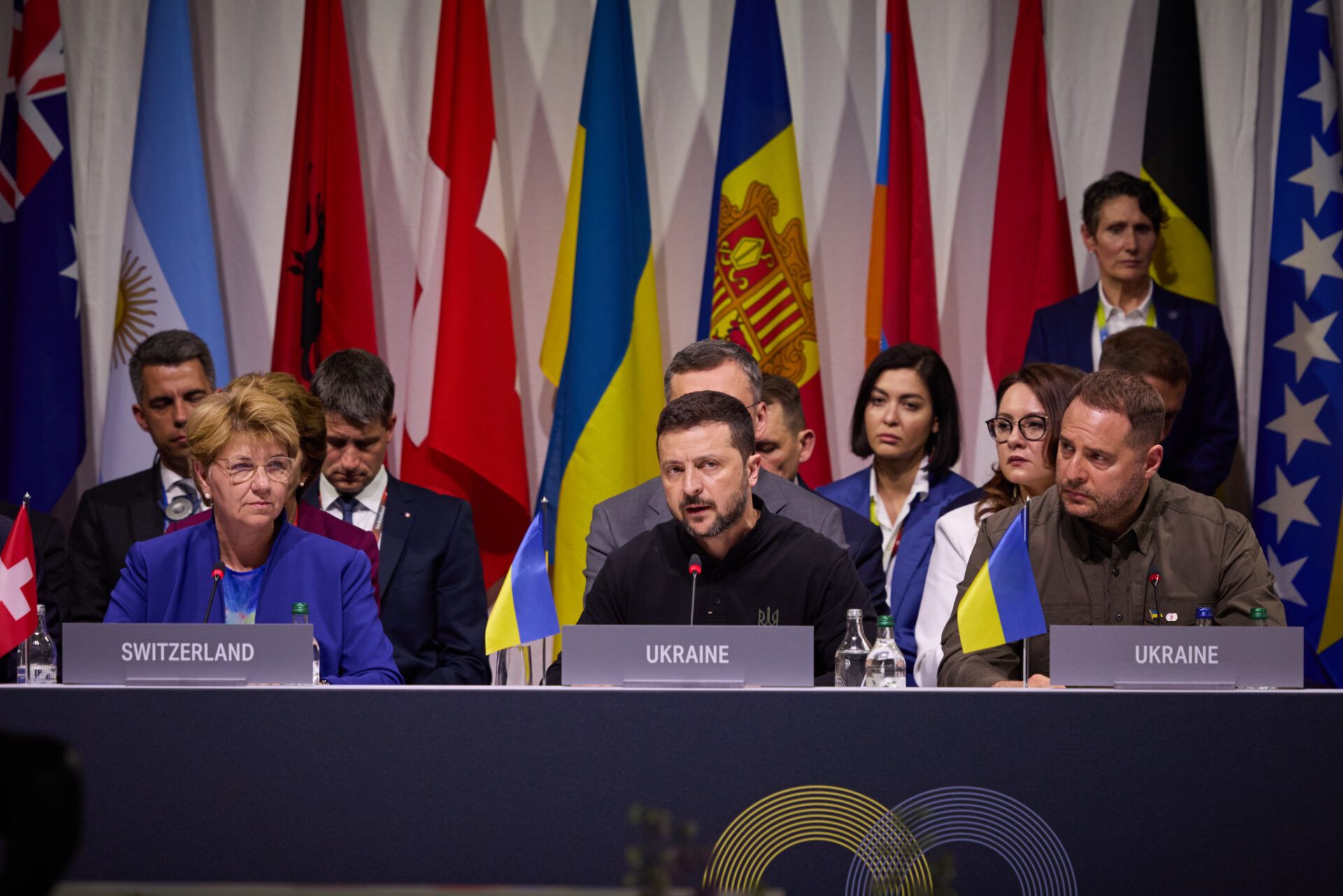
UK and Allies Accuse Russia of Bad Faith
In the UK’s House of Commons, Defence Secretary John Healey delivered a sharp rebuke to Moscow. “While Putin has said he declared an Easter truce, he broke it; while Putin says he wants peace, he has rejected a full ceasefire,” Healey told lawmakers. “He continues to play for time in the negotiations.”
Across Europe and the United States, there is growing concern that Russia is using peace overtures as a smokescreen while it regroups militarily and reinforces its territorial holds in eastern and southern Ukraine.
Civilian Casualties Continue to Mount
Even as diplomats spar, the violence on the ground remains relentless. Russian drone strikes overnight targeted civilian infrastructure across several regions.
In the Dnipropetrovsk region, a drone attack on a bus transporting workers in Marhanets claimed nine lives, according to regional governor Serhiy Lysak. In the southern city of Odesa, two people were injured and multiple fires broke out following another drone strike that targeted civilian areas, regional Governor Oleh Kiper confirmed.
The attacks come amid renewed fears that Russia is ramping up psychological pressure ahead of any formal ceasefire discussions, targeting not just infrastructure but civilian morale.
The Last Bit, Uncertainty and Stalemate
With Kyiv rejecting what Washington terms a final offer, and Moscow pushing to freeze the conflict on terms favourable to its territorial ambitions, prospects for a negotiated settlement appear dim, at least for now.
Ukraine’s steadfast insistence on restoring full sovereignty clashes head-on with Russian demands for recognition of annexed territories. And as Trump-aligned voices in the U.S. hint at disengagement, Europe may soon find itself bearing more of the diplomatic and military burden of supporting Ukraine.
Yet amid the fog of stalled diplomacy, Kyiv’s message remains clear: peace cannot come at the cost of principle. For Ukraine, territorial integrity is not negotiable, and any talk of peace that compromises that integrity risks prolonging, not ending, the war.
Pahalgam Terror Echoes Israel’s October 7, Time For India To Hit Back Hard And Rethink The Pakistan-Bangladesh Nexus
At least 26 civilians were killed and several others grievously injured in a brutal terrorist attack in Pahalgam, South Kashmir, on April 22, marking a grave escalation in the hybrid war being waged in Jammu and Kashmir. The assault, executed in the Baisaran Valley, involved terrorists opening indiscriminate fire on a group of tourists after verifying their religious identity as Hindu, making it one of the deadliest civilian massacres in the region in recent memory.
This is not merely an act of terror, it is a clear “Pulwama 2.0” moment for India, drawing chilling parallels with the October 7 Hamas-style attack on Israel. The similarities in tactics and targeting are unmistakable. Crucially, the strike occurred just two days after provocative remarks by Pakistan’s Chief of Army Staff, General Asim Munir, fueling strong suspicions of direct Pakistani military involvement.
Initial intelligence inputs suggest that the attackers may have been operatives of Pakistan’s Special Service Group (SSG) masquerading as militants, a classic move by the Pakistani deep state. The attack appears to have been a meticulously planned cross-border operation, possibly sanctioned at the highest levels of Pakistan’s military hierarchy, with the objective of destabilizing Kashmir and shifting regional focus.
Such a blatant provocation demands a calibrated but firm response. As Israel has demonstrated in recent months, sovereign nations cannot afford to appear weak in the face of asymmetric warfare. India must now deliberate an equally forceful counter-strategy, not just for deterrence, but for the preservation of its territorial integrity.
Immediately following the attack, Indian paramilitary and police units were deployed to the site to assist victims and initiate a counter-operation. Home Minister Amit Shah flew into Kashmir to oversee security responses, while Prime Minister Narendra Modi aborted a diplomatic visit to Saudi Arabia and returned to New Delhi to convene a high-level national security meeting the next morning.

Sequence of Events. What Happened in Pahalgam?
Known locally as the “Valley of Shepherds,” Pahalgam is among the most frequented tourist destinations in Kashmir, located about 50 kilometers from Srinagar. On Tuesday, around 2:45 p.m., a group of armed men clad in camouflage reportedly emerged from a nearby forest and launched a surprise attack on civilians at Baisaran meadow, a scenic upland spot accessible only via pony rides or by foot.
Eyewitnesses stated the area was teeming with tourists when the gunmen struck. The attack occurred while U.S. Vice President JD Vance was visiting India, a detail that further illustrates its geopolitical messaging.
Who Claimed Responsibility?
A statement attributed to The Resistance Front (TRF) – a proxy outfit widely believed to be an offshoot of the Pakistan-based terrorist organization Lashkar-e-Taiba, claimed responsibility for the attack. The TRF has previously been used by Pakistan’s intelligence agencies to obscure direct state involvement in terrorism.
The group cited opposition to the Indian government’s policy of issuing residency permits to non-Kashmiris, a process that began after the revocation of Article 370 in 2019, which ended Jammu and Kashmir’s semi-autonomous status. The move allowed Indian citizens from other states to legally reside and work in the region, a development that Pakistan has consistently framed as demographic engineering.
While it could not independently verify the authenticity of the TRF’s statement, Indian intelligence agencies believe the operation involved at least four attackers – two reportedly from Pakistan, and two from Indian-administered Kashmir.
The Broader Strategic Context
This incident is not isolated. It is part of a broader doctrine of Pakistan’s proxy warfare strategy – weaponizing religion, targeting civilians, and exploiting global diplomatic timings. The intent is as much psychological as tactical, to stir fear, disrupt economic revival in Kashmir, and provoke internal unrest.
)
Three Very Important points to consider:
‘1. Pakistan has been systematically probing Indian defences
The attack in Pahalgam is part of a wider, more disturbing pattern. Over the past two years, Pakistan has deliberately shifted the theatre of terror operations from the more heavily secured Kashmir Valley to the hilly districts of the Jammu region – Poonch, Rajouri, Reasi – all of which had seen relative peace for most of the last decade. The renewed focus on Jammu indicates a tactical adjustment: exploiting terrain, testing India’s response, and probing for vulnerabilities.
This push hasn’t been limited to Jammu alone. Ceasefire violations and infiltration attempts along the Line of Control, such as the one recently reported in the J sector, where Pakistani troops crossed the LoC and were pushed back by Indian forces, are further signs of this pattern. Sporadic attacks in the Valley have continued as well, enough to keep Indian forces alert, but not enough to provoke a full-scale retaliation. Together, these actions amount to a calibrated probe — a test of India’s strategic posture across multiple fronts.
2. Rawalpindi’s frustration over losing the Kashmir narrative
For the Pakistan Army, the erosion of its grip over the Kashmir narrative has been a bitter pill to swallow. Since India abrogated Article 370 in 2019, Islamabad has scrambled to mount any meaningful response – diplomatically, militarily, or even rhetorically.
International bodies have largely shrugged, the OIC has offered only token noises, and the Valley – once a hotbed of separatist sentiment – has seen record tourism and credible democratic elections. The symbols of “normalcy” that Rawalpindi once mocked are now becoming entrenched, and it has no counter-narrative left.
It is in this context that General Asim Munir’s recent declaration of Kashmir as Pakistan’s “jugular vein” – a line not seriously invoked since the Zia era – must be understood. It wasn’t strategic signaling. It was the cry of an institution watching the central pillar of its ideological identity slip away. The louder the rhetoric grows, the clearer it becomes – Rawalpindi is no longer setting the terms of the Kashmir discourse, it’s reacting to its loss.
3. Diversion from the internal battle
At first glance, it may appear irrational for the Pakistan Army to provoke a major incident at a time when it is firefighting crises on multiple fronts. The TTP continues to get the better of it in the tribal areas. Baloch separatists recently held an entire train of off-duty soldiers hostage in a stunning display of defiance. Relations with Afghanistan – once thought to be manageable under the Taliban – have completely deteriorated. The country is in the midst of a deep political and economic rut.
Logically, this would seem the worst time to open another front with India. And yet, that is precisely what Rawalpindi has done. Why?
Because when things fall apart internally, the Army reaches for the only narrative that still holds the country together – India as the eternal enemy.
Talking about Kashmir, launching attacks, risking retaliation, these are all tools to distract, unify, and reassert the Army’s centrality in Pakistan.
In this calculus, even a deadly terror attack in Pahalgam makes sense – it reactivates the India card, reminds the domestic audience of the Army’s supposed raison d’être, and gives the generals something to rally the country around. It is for this reason that the Pakistan Army is even ready to risk an Indian retaliation. It would only help make the institution that thrives on the “India threat” seem more relevant.
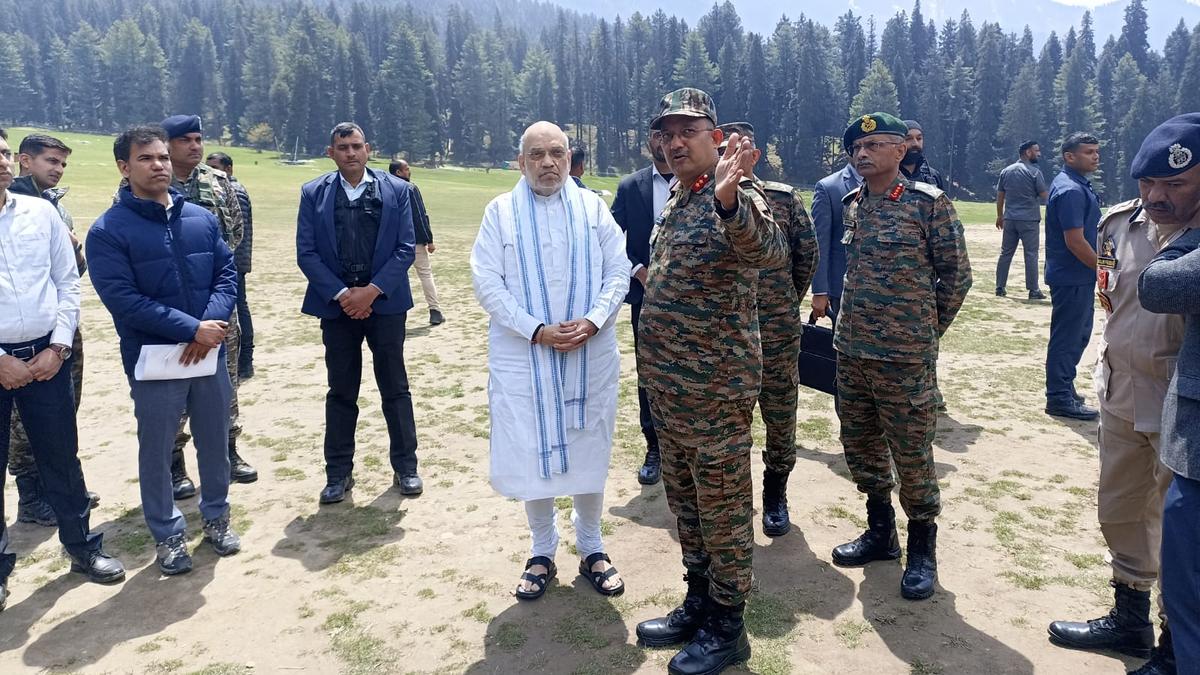
Will India Retaliate Against Pakistan? The Looming Dilemma After Pahalgam
The terror attack in Pahalgam – gruesome in both intent and execution – has reignited a critical question in India’s strategic circles – Should India retaliate? And if so, how?
“This Is an Act of War”
For many in India’s security establishment, the answer is already clear. Tara Kartha, Director at the Centre for Land Warfare Studies and a former official with the National Security Council Secretariat, didn’t mince words: “This is an act of war. That’s how we are seeing it.”
Her remark wasn’t off-the-cuff. It came in the backdrop of a fiery April 16 speech by Pakistan’s Chief of Army Staff, General Asim Munir, where he invoked the two-nation theory and starkly emphasized Pakistan’s “difference from Hindus.”
Kartha connected the dots between rhetoric and reality. “The tone of Munir’s speech and the events in Pahalgam are not coincidental,” she said. “This was a calculated signal.” According to her, unless Pakistan unambiguously condemns the attack and takes concrete action against the perpetrators within 48 hours, a full-blown crisis may be unavoidable.
Pakistan’s Tepid Response
Islamabad’s response has done little to dial down the heat. In a carefully worded early-morning statement, the Pakistani Ministry of Foreign Affairs expressed “concern” over the attack, extended condolences to the victims, and notably referred to the region as “Indian Illegally Occupied Jammu and Kashmir.” That phrasing alone ensured the statement would be seen in India not as an olive branch, but as salt on fresh wounds.
Will India retaliate?
Public pressure on the Modi government — already known for its muscular posture — is immense. There’s a prevailing expectation, especially among the BJP’s support base, that some form of retributive action is inevitable. But voices of caution remain.
But inaction carries its own risks. Another terror attack left unanswered could embolden Pakistan-based elements, undermine India’s deterrent posture, and damage public confidence in the government’s national security capabilities.
From Pulwama to Pahalgam – The Pattern Is Repeating
This is Pulwama 2.0, and possibly worse in its geopolitical calculus. Much like the 2019 Pulwama attack that triggered the Balakot airstrikes by India, the Pahalgam incident appears to be a calibrated escalation. Sources within India’s intelligence community indicate this could be the handiwork of Pakistan’s military establishment, orchestrated under the leadership of General Asim Munir, who is believed to be engineering heightened tensions for internal consolidation and regional leverage.
India, in this instance, cannot afford to respond with just condemnation. Israel’s response to Hamas set a precedent – that sovereign states must retaliate to protect civilian lives and national integrity. India must now consider a proportionate and unflinching response – diplomatically, militarily, and economically.

The Pakistan-Bangladesh Nexus
What complicates the regional equation further is the recent uptick in diplomatic and strategic alignment between Pakistan and Bangladesh under Mhd Yunus, analysts fear a possible drift in Bangladesh’s internal equilibrium – one that Pakistan’s ISI is all too eager to exploit.
It is imperative for India to not just address the immediate security lapse in Pahalgam but also reassess the evolving Bangladesh-Pakistan proximity, especially given the long-standing history of ISI using Bangladeshi soil for proxy operations in the Northeast.
In the aftermath of the attack, Indian Home Minister Amit Shah and the country’s top intelligence chiefs rushed to Srinagar. Prime Minister Narendra Modi, cutting short a strategic visit to Saudi Arabia, chaired a high-level security meeting to craft a comprehensive response. These are necessary steps -0 but insufficient if not followed by long-term recalibration.
India must:
Launch targeted counter-terror operations across the Line of Control if actionable evidence confirms Pakistani involvement.
Internationally expose the dual-face of Pakistan — one that talks peace but wages asymmetric war through terror proxies like TRF and LeT.




